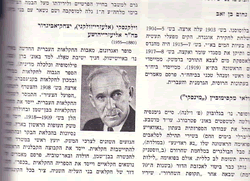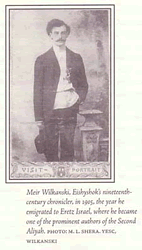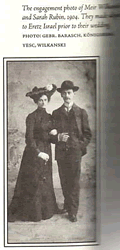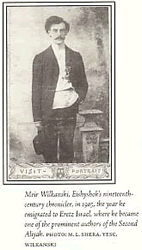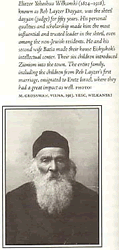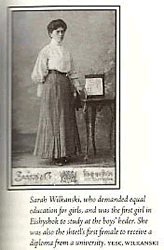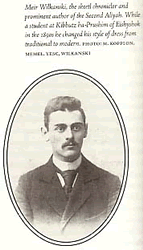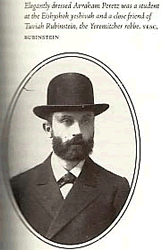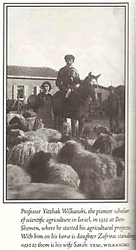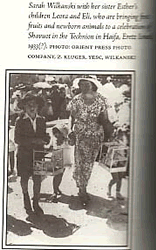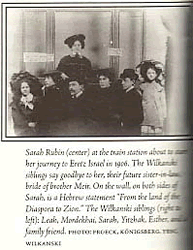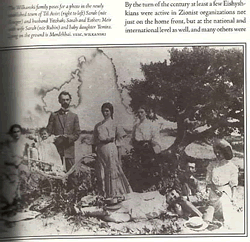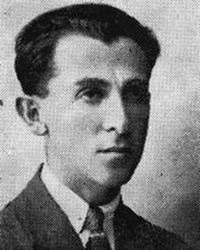#vki-16:
Mordechai Volcani
? Birth:
? 1891
? Eišišk?s, Šal?ininkai District Municipality, Vilnius County, Lithuania
? Death:
? 1935 (44)
? Rehovot, Center District, Israel
? Immediate Family:
? Son of Eliezer Yehoshua Vilkanski and Batya Volkansky
Husband of Shoshana Elazari-Volcani
Father of David Elazari-Volcani; Yonatan Elazari-Volcani and <private> Elazari-Volcani
Brother of Yitschak Avigdor Elazari-Volcani;Meir Elazari-Volcani; Sarah Volcani Pavsner; Esther Goldberg and Rivka Rabinovich
Author Elazari-Volcani, Isaac
Title The communistic settlements in the Jewish colonisation in Palestine / by I. Elazari-Volcani
Imprint Tel-Aviv : Palestine Economic Society, 1927
Year 1927
Pages 140 p.
Subject Kibbutz--History;
Series Publications of the Palestine economic Society
Language ENG System No 1125694
Author Elazari-Volcani, Isaac
Title The Dairy industry as a basis for colonisation in Palestine / by I. Elazari-Volcani ; assisted by A. Sussmann ; [translated from the Hebrew]
Location Imprint Tel Aviv : Amanut Printing-Press, 1928
Year 1928
Pages xii, 205 p.
Subject Dairying--Economic aspects--Israel-- to 1947;
Series Publications of the Palestine economic Society
Language ENG
Ad.Author Sussmann, A.
System No 1112008
Author Elazari-Volcani, Isaac
Title Planned mixed farming / by I. Elazari-Volcani ; [translated from the Hebrew by M. Simon and S. Hestrin]
Location Imprint Rehovot : [s.n.] ; Tel-Aviv : Palestine Pub. Co., 1938
Year 1938
Pages xv, 154 p. : map
Subject Agriculture--Israel--Planning; Agricultural systems--Israel;
Note At head of title: The Jewish Agency for Palestine, Agricultural research Station, Rehovot
Language ENG
Ad.Author Tahana leheqer ha-haqlaut (Rehovot, Israel) System No 1112446
Author Elazari-Volcani, Isaac
Title The transition from primitive to modern Agriculture in Palestine / by I. Elazari-Volkani
Location Imprint Tel-Aviv : [s.n.] ; Tel-Aviv : Ha-Poel Hazair, 1925
Year 1925
Pages 52 p.
Subject Agriculture--Israel--1917-1947; Agriculture--Israel--History;
Series Publications of the Palestine economic Society ; 004
Language ENG
Eisiskes/Lida/Vilnius
Eliezer Yehoshua VOLKANSKY born c 1850(son of Elia?)
Spouse: Batya ALTSCHUL Children:
1. Yitschak Avigdor VOLCANI born in Eisiskes 1880 died 1955. Spouse:
Sarah
daughter of Benjamin KRIEGER Children:
-----------------Zafrira VOLCANI
------------------Benjamin Elezari VOLCANI Died: 6 Feb 1999, La Jolla,
Ca.
---------------------Ruth VOLCANI
2. Meyer VOLCANI Spouse: Sara RUBIN Children:
-----------------Dvora VOLKANSKY Born: Rechavia, Is.
------------------Raanan (Rani) VOLKANI Born: Rehovot, Is. died in
spring of
2002
--------------------Temira VOLKANSKY Born: Rechavia, Is.
------------------------Leah Daga VOLKANSKY Born: Rechavia, Is.
3. Sarah VOLCANI
4. Esther VOLCANI Spouse: Pincus GOLDBERG Children:
-----------------Eliezer (Ellie) GOLDBERG
-----------------------Liora GOLDBERG Spouse: Chaim POCKER
5. Mordechai VOLCANI-ELEZARI Spouse: Shoshana Children:
-------------Ilzi VOLCANI-ELEZARI
--------------David VOLCANI-ELEZARI
---------------Jonathan VOLCANI-ELEZARI
Eisiskes/Lida/Vilnius May 1858;
Surname Given Name Father Relationship
VILKANSKI Kushel Shmuil Head of Household
VILKONSKI Symkha Itsko Head of Household Absent 1857 Added 23 December
1856,
no. 7
Shchuchin/Lida/Vilnius May 1858;
Surname Given Name Father Relationship
VOLOCHANSKI Movsha Nokhim 53
VOLOCHANSKI Symka Menakhim Movsha's wife 47
VOLOCHANSKI Mordukh Movsha 23
VOLOCHANSKI Liba Meer 18 Mordukh's wife
VOLOCHANSKI Meer Movsha 10
VOLOCHANSKI Shmuilo Nokhim
Vasilishki/Lida/Vilnius May 1858;
VOLCHINSKI Rubin Berko Head of Household 57
VOLCHINSKI Ryvka Meer Wife 35
VOLCHINSKI Elia Rubin Son 30
VOLCHINSKI Mikhla Berko Daughter-in-law 31 Elia's wife
VOLCHINSKI Leizer Elia Grandson 8
VOLCHINSKI Malka Elia Daughter 2 Twin
VOLCHINSKI Itka Elia Daughter 2 Twin
VOLOCHINSKI Shmuilo Menkhel Head of Household 34
VOLOCHINSKI Meriash Getsel Wife 32
VOLOCHINSKI Mikhla Shmuilo Daughter 1 ------------------------
1 Anton Wilcenski Georgenburg, Russia 1906 40
2 Dorel Wilkanski ...zni 1907 31
3 Henriette Wilkanski Riga 1905 54
4 Stanislaw Wilkanski Wergelandi, Russia 1909 26
1 Simche Wolgansky Mileiziz 1906 44
2 Chaja Woljansky Samarowiczi, Russia 1914 16
3 Elka Woljansky Samarowiczi, Russia 1914 10
4 Feige Woljansky Slomin 1904 20 Passenger
5 Geade Woljansky 1906
Leib Wolkionsky 1901 16 Norman Morantz (#14652)
5607 Parkhaven Ave.
Cote St-Luc, QC
H4W 1X2
Canada
nmorantz@videotron searching Wolchansky
WOLTSHANSKI A Y 1902 Kybartiai, Lith. Hamelitz #224 for fire victims in
Bobriusk & Anikst
WOLTSHANSKI Y 1898 Kybartiai, Lith. Hamelitz #167
WOLTSHANSKI Yosef 1900 Kybartiai, Lith. Hamelitz #246
WOLOZINSKI Tzadok 1902 Kaunas, Lith. Hamelitz #238 Kloiz Har Shasee
February 9, 1999
Media Contacts: Janet Howard or Cindy Clark, (619) 534-3624
jehoward@ucsd.edu; cclark@ucsd.edu
Renowned Scripps Microbiologist
Benjamin Volcani Dies
Benjamin Volcani, who discovered life in the Dead Sea and pioneered biological
silicon research at Scripps Institution of Oceanography at the University
of California, San Diego, died Saturday from complications related to
kidney failure. He was 84.
In 1969, Volcani's research group established the biologically active
role that silicon plays in the most fundamental life processes through
his work with diatoms, single celled aquatic plants that make up the base
of the marine food chain. "Ben was the first to show that silicon
is essential for DNA synthesis in diatoms. That is very important because
diatoms play a critical role in the food chain in the ocean," said
Victor D. Vacquier, a professor of marine biology at Scripps.
Volcani was the first to show that silicon was biologically active. For
the past 35 years, he concentrated his research on the various aspects
of the biological roles of silicon, from the electron microscopy of diatom
shells to the isolation of genes specifying the proteins transporting
silicon into cells.
In 1996, Volcani was presented with an award from Dow Corning Corporation
in recognition of "a lifetime of dedication to unraveling the secrets
of silicon."
"I think everyone in the field agrees that if it weren't for Ben's
tenacity in sticking to the problem we wouldn't be anywhere near where
we are today in the field of the biology of silicon," said Mark Hildebrand,
a Scripps staff research associate who worked with Volcani.Volcani's research
interests focused on the biochemistry of halophilic (salt-loving) microorganisms,
microbial metabolism, biological mineralization, the biochemistry and
ultrafine structure of diatoms and other siliceous organisms, and the
cell walls of dinoflagellates, which sometimes cause "red tides."
He also investigated whether silicon may play a role in certain types
of cancer in human cells.
Born in 1915 in Ben-Shemen in what is now Israel, Volcani received his
master's of science degree in microbiology from Hebrew University in Jerusalem
in 1936. That same year, he found that the Dead Sea, so called because
it was thought to be too salty to sustain life, in fact supports several
types of microorganisms now classified as halophilic archaebacteria. In
1941, Volcani received the first doctoral degree in microbiology to be
awarded by Hebrew University and wrote the first Ph.D. thesis in Hebrew.
His discovery of microorganisms in the Dead Sea was the focal point of
his work from 1936 to 1945 and was the theme of his doctoral thesis.Volcani
served on the staff of the Weizmann Institute of Science in Rehovoth,
Israel, from 1939 to 1958 and was appointed head of the Institute's Section
of Microbiology in 1948. During the 1940s, he also spent time in the United
States as a research fellow at the University of California, Berkeley;
Hopkins Marine Station of Stanford University; the California Institute
of Technology; and the University of Wisconsin.
Volcani was a research associate at the Pasteur Institute, Paris, in 1951.
He returned to California in 1956 as a research associate at the University
of California, Berkeley, and in 1959 was appointed professor of microbiology
at the Scripps Institution of Oceanography, University of California,
San Diego. In 1966, he served as consultant to NASA on the microbiology
of lunar samples.Volcani was a member of the Society of the Sigma Xi,
American Society for Microbiology, Biochemical Society of Great Britain,
Society of General Microbiology, Great Britain, Geochemical Society, the
Western Society of Naturalists, and the American Society for Cell Biology.
He is survived by his wife of 50 years, Toni; son, Yanon Volcani; daughter-in-law,
Rory Divine; and a grandson, Doron Volcani, all of La Jolla.
### ### ### Please note: a photo of Volcani is available
Scripps Institution of Oceanography on the World Wide Web:
http://sio.ucsd.edu SIO Communications
siocomm@sio.ucsd.edu Scripps Institution of Oceanography
University of California, San Diego
www@sio.ucsd.edu
Psychological Testing Services International was founded by Yanon Volcani,
Ph.D., a Clinical Psychologist practicing in San Diego, California. Dr.
Volcani received his Doctorate in Clinical Psychology from Michigan State
University in 1980. He has been working with children, adults and families
for over twenty years, providing psychotherapy, psychological evaluations
and clinical consultations, as well as studying children's and adults'
fantasy expressions. Dr. Volcani was the Clinical Director of Southwood
Adolescent Psychiatric Inpatient Unit in Chula Vista, California; the
Psychology Director of Southwood Adolescent Psychiatric Residential Treatment
Program; and has been teaching courses in child and adolescent psychotherapy
for over fifteen years at the San Diego campus of the California School
of Professional Psychology.
A highly respected mental health practitioner in the San Diego area, Dr.
Volcani is often appointed by the San Diego Juvenile Court and the San
Diego Family Court to provide evaluations and therapy to children, adults
and families.
Dr. Volcani collaborated with Constance Dalenberg, Ph.D., Professor of
Psychology at the San Diego campus of the California School of Professional
Psychology, and Gary Stollak, Ph.D., Professor of Psychology at Michigan
State University, in developing the present tools for assessing children's,
adolescents' and adults' psychological and emotional well-being. Dr. Dalenberg
and Dr. Stollak are both widely published clinicians and researchers in
the area of child, adult and family studies.You are welcome to e-mail
Dr. Volcani through PTSI, or contact him by phone at 858-459-5557.Our
esteemed colleague, Benjamin Elazari Volcani, died in La Jolla on February
6, 1999, age 84, concluding a 40-year career at the Scripps Institution
of Oceanography, UCSD. Ben was born on January 4, 1915, in Ben-Shamen,
Palestine. His father, Itzhak, as a young Zionist in Lithuania, had studied
agricultural economics before emigrating to Palestine in 1908. He eventually
became one of the world leaders in the field, and the Volcani Institute
in Israel is named in his honor.Ben had two sisters, both of whom predeceased
him. As a teenage boy, Ben wanted to become an actor (he was notably good
looking), but as an undergraduate, the study of biology captured his interest.
Both his M.Sc. degree (1936) and Ph.D. (1940) were from the Hebrew University,
Jerusalem. His Ph.D. thesis was the first ever written in Hebrew ("Studies
of the Microflora of the Dead Sea").
Ben made two major contributions to science, and they divide his career into distinct phases. The first phase dealt with his discovery of life in the Dead Sea, until then thought to be too salty to sustain life. The second phase centered on his discovery that silicon, believed to be biologically inert, is not only biologically active, but is required for many biochemical pathways in diatoms. The role of diatoms in the global carbon cycle is thus largely dependent on silicon metabolism in diatoms.
In 1935, in pursuit of his Ph.D., Ben found that sediment samples from the Dead Sea contained living microorganisms; he isolated the first halophilic bacteria ever reported and named the genus Halobacterium. With the modern realization that these cells are in the Domain Archaea, the genus has been renamed Haloarcula. From these samples, Ben also isolated the first halophilic protozoa and halophilic unicellular algae ever reported.
From 1936-1944 he published six papers in the journal Nature on these completely new hypersaline-adapted microorganisms. They were so unusual that in 1936, seeking information on their biology, Ben journeyed to Delft to the laboratory of A.J. Kluyver, the greatest microbiologist of that time. He spent one year in Delft and one year in Utrecht, before returning to Palestine in 1939 as a staff researcher at the Sieff Research Institute in Rehovot, which later became the world renowned Weizmann Institute of Science. The two years in Holland were Ben's first foreign experience. He had wonderful memories of working with Kluyver and he made life-long friends among the students and postdoctorals.Ben was a supreme packrat who never threw anything away. He kept the original 1930's collections of Dead Sea sediments in a cabinet in his office at Scripps. In the 1990s, while preparing for a meeting in Spain devoted to halophilic bacteria, he opened some of the 60 year old liquid cultures of the original Dead Sea sediment and succeeded in growing out several microorganisms hitherto unknown. In collaboration with Professor Antonio Ventosa and coworkers in Barcelona, Ben was co-authoring papers on these new species at the time of his death. His last co-authored paper describing a new hypersaline bacterium was published in the spring of 1999, concluding the first phase of his 63 year career, that of describing novel, hypersaline microorganisms. Ben's life-long contribution to the discovery of such microorganisms was honored by the naming of the eubacterial genus Volcaniella and the archaeal species Haloferax volcanii.
Ben remained on the staff of the Weizmann Institute from 1939-1958. In 1945-1946 he took his first sabbatical in the Department of Plant Nutrition at UC Berkeley and in 1946-1947 worked with the famous microbiologist C. B. van Niel (a student of Kluyver's), at Stanford's Hopkins Marine Station in Monterey, California. It was there that he met Toni Jackson, to whom he was married in March of 1948 in New York City. Two weeks later they were on a ship to then-Palestine, still governed by the British.
The long underground struggle
of the Jews in Palestine for independence was coming to fruition; a member
of the Resistance, Ben smuggled in his baggage a small field-radar unit.
One month later, on May 15, the new state of Israel was born, sparking
the Arab-Israel war. Toni remembers walking to the market in Rehovot,
about one mile from their house, and diving into foxholes along the road
when pairs of small two-seater Arab planes came over on bombing runs.
They came in low, each dropping its 25 lb. bomb as it flew off. Actually,
the first bomb of the war fell on the street in front of the Volcani's
house. Everyone ran for cover to the garden's slit-like trench except
Ben's mother who grabbed a broom and began sweeping the rubble from the
lawn and front porch into the street. (Viewing Ben's office at Scripps
would convince anyone that Ben's mother's penchant for neatness was not
a dominant genetic trait.) The war ended in January 1949. Just two weeks
before the end of the war, Yanon, their son and only child was born. He
is now a successful clinical psychologist in La Jolla.
During his first sabbatical from the Sieff Institute in 1947-48, Ben had
spent the winter at Caltech in Pasadena, and the spring of 1948 at the
University of Wisconsin in Madison. Upon his return to the now-Israel,
he was given a permanent post at the Sieff, now much enlarged as the Weizmann
Institute of Science. He took one break in 1951 to work with Professor
Jacques Monod at the Institute Pasteur in Paris, and then settled down
in Rehovot to continue his study on the Dead Sea microorganisms.He took
his second sabbatical in 1956, spending most of it with Professor H. A.
Barker at U.C. Berkeley. He extended his leave to come to the Scripps
Institution of Oceanography to work with Professor C. E. Zobell. While
in La Jolla in 1959, Scripps' Director, Roger Revelle, offered Ben a faculty
position at Scripps, which was soon to become the nucleus for the beginning
of the new UCSD campus. Ben accepted, and the family moved to La Jolla
with their possessions, which filled three suitcases.
At that time La Jolla realtors were still observing a traditional agreement
not to rent or sell to Jews. But, with the connivance of a more liberal
realtor (who needed the commission) they were shown lots. The realtor
asked, "By the way, you aren't Jewish, are you?" Ben's response
was, "Why yes, indeed we are Jewish." The realtor's response
was, "Volcani, sounds Italian to me, just don't tell anyone anything
different." Ben liked telling
this story to show how La Jolla has changed. Ben and Toni found an "unbuildable"
lot, which was therefore unbelievably cheap, in one of the most swanky
sections of La Jolla. They gave their entire meager savings as a down
payment (whereupon the realtor offered to buy the lot back for double
the price).
It was the move to Scripps that began Ben's second major career achievement.
He decided to focus on diatoms, one of the very few organisms that use
silicon rather than calcium for their skeletal structures. Silicon is
one of the most abundant elements on earth, and in 1959 essentially no
one was working on its metabolism. The biology of silicon had been shunned
by all biochemists, the dogma being that it was inert. Ben realized that
diatoms, whose life cycle is based on silicon, provided an ideal experimental
canvas.
From 1959 onward, Ben's lab produced a stream of multifaceted discoveries
centered on biologically active silicon in marine diatoms. Ben's lab became
the world focal point for the study of silicon metabolism and biomineralization
at the molecular level. For many years Ben's lab was the only one engaged
in the study of bioactive silicon; he kept this field alive and growing
during the time when no one else dared venture into it. His lab embraced
every experimental technique, from elegant electron microscopy of diatom
shells to gene cloning and the expression of silicon transporting proteins
in frog eggs. Ben invented ways to synchronize the cell division cycle
of diatoms. He showed that silicon activates the gene coding for the polymerase
enzyme that copies diatom DNA. Ben was also interested in the toxic and
pathological effects of polysilicates, such as talc and asbestos, on mammalian
cells in tissue culture, and he was the first to do tissue culture at
Scripps. He also spent a one year sabbatical at the University of Swansee
studying the effects of polysilicates on mammalian cells. He even published
papers on the uptake of silicic acid by rat liver mitochondria.
Ben's studies of silicon metabolism often involved growing diatoms of
various species in different concentrations of silicon and then studying
the effect on specific metabolic pathways. These experiments studied pigments,
lipids, amino acids, cell wall synthesis, DNA synthesis, ribosomes, sodium-potassium
membrane pumps, cell membrane characterization, glycolate metabolism,
cyclic nucleotide metabolism, protein kinases, and a catalog of genes
that were turned on by silicon. Several papers centered on the effects
of silicon on photorespiration in diatoms. He published well over 100
papers related to silicon metabolism and co-edited the book Silicon and
Siliceous Structures in Biological Systems (Springer, 1981). Ben had continuing
grants from The National Institutes of Health for 32 years; he trained
many doctoral students and had a constant stream of postdoctoral associates
and visitors passing through the lab until his retirement in 1985. Although
Emeritus, he remained active for another decade, most of which involved
collaborative work with a senior research associate, Mark Hildebrand.
Ben's major contributions to this collaboration with Mark were to keep
the diatoms growing in tens of liters of culture and to synchronize their
divisions. He could be found late at night on the weekends wheeling giant
culture vats down the hall to the autoclave. He was totally involved in
doing "hands-on" research, publishing papers and worrying about
funding, until the very end of his life. In 1996 the Dow-Corning Company
gave Ben a special award in recognition of "a lifetime of dedication
to unraveling the secrets of silicon."
Ben Volcani had a passion for
the scientific literature and for talking to people. For decades he would
arrive at the Scripps library early on Saturday and spend the entire day
reading the new journals. He was absolutely unselective and read the table
of contents of every journal regardless of scientific field or language.
He would leave stacks of journals in the library reading room as testaments
to his Saturday battle with the literature. He would put a little Z on
the back of each journal he had read.
He would take a break for lunch out on the Hubbs Hall balcony. Without
fail he would engage the tourists who came to look at the view. These
conversations with visitors could last for an hour. If they had small
children he would dash into his office and return with tennis balls and
beach toys. He kept boxes of these items under his desk, all of which
he had found during his walks on La Jolla Shores Beach, walks that he
always loved to take. Ben enjoyed talking to people and hearing their
stories so much that he could have been an excellent clinical psychologist
like his son, Yanon. When he came back from foreign travel he always had
stories about interesting people he had met; none of these stories were
related to science. He had enormous charm and warmth and his eyes sparkled
with happiness.Ben's ease with strangers, from dignitaries to visiting
families, and also with students, probably stemmed from his upbringing
in one of Israel's most distinguished science families and the consequent
stream of international scholars and dignitaries passing through his family
home. Once, without warning, he brought a man into his lab at Scripps
and said, "I want you to meet an old friend of mine who is a president.
He is the president of a very small, but very important country."
The man with him was Efraim Katchalski, the then President of Israel,
who, being a biochemist, immediately wanted to know what was going on
in the lab. On another occasion Ben came into his lab towing a smallish,
frail, shy man and said, "I want you to meet my old friend Fritz."
There standing before us was Fritz Lipmann, a Nobel Laureate for the discovery
of coenzyme A and a god of biochemistry.
In the later years Ben and
Toni were blessed by Rory Devine, Yanon's wife, and then by a grandson,
Doron. If ever there was an involved grandfather, it was Ben. He would
go shopping for toys and gadgets for Doron, and he and Doron developed
a very close bond. It was the ideal relationship everyone wants to see
between grandparent and grandchild. Some of the toys Ben would bring to
the lab for demonstrations. One was a sticky rubber octopus that you threw
at a flat wall hitting close to the ceiling. The octopus would then walk
down the wall, sticking with each leg for just a few seconds. Ben liked
the octopus so much that he bought many, which he distributed to parents
of small kids in Marine Biology.Ben Volcani was a fixture at Scripps,
his long white hair blowing in the sea breeze as he walked around campus.
We will remember his great interest in any scientific discovery and how
excited he would be when you told him about your latest experiment, or
listened to him recount his. He approached all facets of life with unmatched
intensity and passion. We will always remember his interest in science
and people, his warm conversation, friendship andcharm.
Farooq Azam
Andrew A. Benson
Victor D. Vacquier, Chair
